약물로 인한 혈청병 Serum sickness caused by drugs
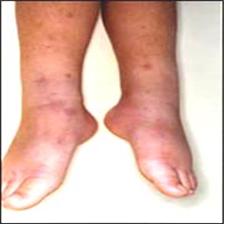
사진 59. 혈청병으로 생긴 헤노흐쉰라인 자색반으로 분 다리.
Copyright ⓒ 2011 John Sangwon Lee, MD., FAAP

사진 60. 벌에 쏘인 후 혈청병이 생길 수 있다.
Copyright ⓒ 2011 John Sangwon Lee, MD., FAAP
약물로 인한 혈청병의 원인
-
혈청병은 항원 항체 이상 반응으로 생기는 면역 복합 반응이고 일종의 지연 약물 알레르기의 일종이다.
-
파상풍, 디프테리아, 그 외 감염병을 치료하기 위해 소나 말의 혈청으로 만든 혈청약으로 치료 받았던 과거에 이 병이 있었다.
- 소나 말의 혈청에 특정 세균을 죽일 수 있는 특정 항체가 들어 있을 수도 있고 다른 종류의 단백질 즉 항원이 혈청에 들어 있다.
- 특정 항체가 든 혈청으로 치료하는 것은 일종의 수동 면역치료이다.
-
수동 면역치료를 받을 때 쓰는 혈청 속에 항체도 있지만 다른 종류의 단백질 즉 항원도 들어 있다.
-
혈청약 성분 속에 든 항원과 몸속에 있는 항체가 이상 반응을 일으켜 혈청병이 유방될 수 있다.
-
이와 같이 소나 말의 혈청으로 만든 혈청약이나 사람의 피 등으로 만든 약, 또는 항생제 등으로 어떤 병을 치료할 때 혈청병이 생길 수 있다. 약물 과민증 참조
-
혈청 성분이 든 약물(혈청약) 등으로 치료 받은 후 1~3일 경에 혈청병이 나타날 수 있고, 약 1∼4주 경에 나타날 수 있다.
-
항사독소(항뱀독소) 혈청약으로 치료 받거나 페니실린, 설폰아마이드, 덱스트란, 세팔로스포린 등 약물로 치료받거나, 그 외 어떤 종류의 약물을 먹거나, 마시거나, 흡입하거나, 비강 속이나 입안에 넣거나, 피부나 점막에 바르거나, 항문이나 질강 속에 넣거나, 벌 쏘임 등 곤충에 쏘이거나 물리거나, 또는 어떤 음식물을 먹은 후에도 혈청병이 생길 수 있다.
-
동물 혈청 성분이 든 약을 주사로 맞았을 때, 페니실린, 설파제, 스트렙토마이신 등 항생제로 치료 받을 때 약으로 인한 아나필락시스, 혈청병, 또는 약물 부작용이 생길 수 있다. p.00 페니실린 알레르기 참조
약물로 인한 혈청병의 증상 징후
-
혈청병의 전형적 증상 징후는 열·두드러기·피부 소양감, 두드러기 등 피부 발진, 관절통·관절염·근육통·림프절 비대, 피로 등이다.
-
혈청병으로 생긴 두드러기는 일반적으로 더 심하고 그로 인해 상당히 가렵다.
-
대부분의 혈청병의 증상 징후가 나타난 후 바로 적절히 치료하면 혈청병의 증상 징후가 1주 정도 계속되다가 자연히 낫는 것이 보통이다.
-
드물게는 혈청병으로 심장염, 사구체신염도 생길 수 있다. [부모도 반의사가 되어야한다–소아가정간호백과]-제10권 소아청소년 신장 비뇨 생식기계 질환–신증후군 참조
약물로 인한 혈청병의 진단
-
병력·증상 징후·진찰소견 등을 종합해 진단할 수 있다.
-
혈청약 주사를 맞았거나 그 외 약물로 치료받았거나 벌 등 곤충에 쏘였다는 사실 등을 참작해 혈청병을 진단할 수 있다.
-
혈청병의 초기 증상 징후는 다른 병의 증상 징후과 비슷한 데가 많아서 혈청병과 다른 병을 감별 진단해야 한다.
약물로 인한 혈청병의 치료
-
경미한 혈청병은 의사의 지시에 따라 집에서 적절한 약물로 치료할 수 있다.
-
혈청병을 베나드릴(Benadryl)이나 아타락스(Atrax) 등 1세대 항히스타민제로 치료하든지 코르티코스테로이드제 및, 또는 항히스타민제로 치료한다.
-
혈청병을 유발시켰다고 생각되는 약물은 앞으로 더 이상 사용해서는 안 된다.
-
심한 혈청병은 병원 입원 치료가 요한다.
약물로 인한 혈청병의 예방
-
과거에 혈청병을 유발시켰던 약물이나 그 외 항원에 더 이상 노출되지 않도록 해야 한다. 아나필락시스을 예방 할 때와 거의 같게 혈청병을 예방한다.
약물 알레르기와 약물 부작용의 감별 진단 Differential drug diagnosis of drug allergy versus drug side effects
1. 약물에 의한 피부 발진(약진/약물 발진) Drug eruption
-
약물에 의한 피부 발진을 약물 피부 발진, 약물 발진, 또는 약진(藥疹)이라고 한다.
-
약물 치료를 받을 때 약물 알레르기가 생길 수 있다.
-
두드러기·물집·탈피·홍반·구진·홍반성 구진, 홍역 꽃과 거의 비슷한 피부 발진 등이 생길 수 있다. [부모도 반의사가 되어야한다–소아가정간호백과]-제17권 소아청소년 피부질환–피부 발진 참조
-
약물 부작용으로 피부 발진이 생길 수 있다.
-
약물 유해 작용으로도 피부 발진이 생길 수 있다
-
때로는 피부 발진이 약물 부작용으로 생겼는지 약물 알레르기로 생겼는지 또는 약물 유해 작용으로 생기는지 감별하기가 어렵다.
-
이때 생긴 피부 발진을 그냥 “약진”이라 한다.
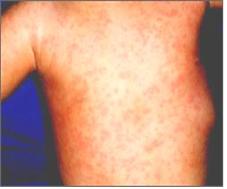
사진 61. 약물에 의한 피부 발진(약진).
Copyright ⓒ 2011 John Sangwon Lee, MD.,FAAP

사진 62. 약물에 의한 피부 발진(약진).
Copyright ⓒ 2011 John Sangwon Lee, MD., FAAP
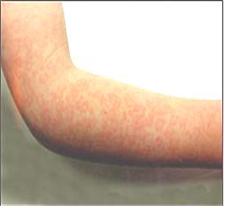
사진 65. 약물에 의한 피부 발진(약진).
Copyright ⓒ 2011 John Sangwon Lee, MD., FAAP

사진 66. 약물에 의한 피부 발진
Copyright ⓒ 2011 John Sangwon Lee, MD., FAAP.

사진 63. 약물에 의한 피부 발진(약진)
Copyright ⓒ 2011 John Sangwon Lee, MD., FAAP
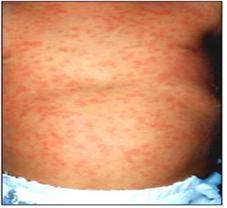
사진 64. 약물에 의한 피부 발진(약진)
Copyright ⓒ 2011 John Sangwon Lee, MD.,FAAP
2. 약물에 의한 열(약물 열) Drug fever
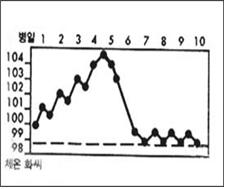
그림 67. 약물로 치료를 받을 때 약물 부작용이나 약물 알레르기로 열이 날 수 있다.
Copyright ⓒ 2011 John Sangwon Lee, MD., FAAP
-
약물 항원 항체 이상반응으로 생기는 약물 알레르기로 인해 열이 날 수 있고,
-
약물 치료를 받을 때 약물 부작용의 증상 징후로 열이 날 수 있다.
-
약물 유해 작용으로도 열이 날 수 있다.
-
약물 알레르기의 증상으로 열이 날 수 있고 약물 부작용으로 열이 날 수 있다.
-
어떤 병을 약물로 치료받을 때 앓고 있는 원래 병 자체에 의해 열이 나지 않고 약물 알레르기로 인해 열이 나는지, 약물의 부작용으로 열이 나는지, 또는 약물 유해 작용으로 열이 나는지 확실히 모를 때 약물에 의한 열, 또는 약물 열이라고 한다.
-
이때, 섭씨 38~43도 정도 열이 날 수 있다.
-
페니실린이나 세팔로스포린(Cephalosporin)등 항생제, 페니토인(Phenytoin)이나 펜노바비탈(Phenobarbital) 등 항경련약, 다우노루비신(Daunorubicin) 등 항종양 치료제 등으로 치료를 받는 중 약물 부작용으로 인해 약물 열이 날 수 있다.
-
약물 치료 시작 7~10일 경에 약물 열이 나기 시작하는 것이 보통이다.
-
쓰던 약물을 중지한 후 2~3일 내 열이 떨어지는 것이 보통이고 때로는 호산구 증가 및 피부 발진 등을 동반할 수 있다.
3. 약물에 의한 폐렴 Drug pneumonitis
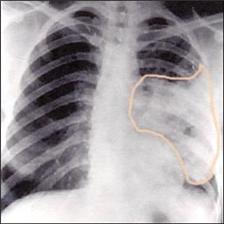
사진 68. 폐렴이 왼쪽 폐에 있다. 약물 부작용으로 폐렴이 생길 수 있다.
Copyright ⓒ 2011 John Sangwon Lee, MD., FAAP
-
헤로인(Heroin)이나 메사돈, 그 외 습관성 약물을 쓰거나 그 외 약물로 치료를 받을 때 약물 부작용으로, 또는 약물 알레르기로 인해 폐렴이 생길 수 있다.
-
또 약물 유해 작용으로 폐렴이 생길 수 있다.
-
약물로 인해 폐 속에 비정상적으로 체액이 괴어 폐수종(肺水腫)도 생길 수 있다.
-
어떤 경우, 약물 알레르기로 인해 폐렴이 생겼는지, 약물 부작용으로 폐렴이 생겼는지, 또는 약물 유해 작용으로 폐렴이 생겼는지 확실히 알 수 없는 경우도 있다.
-
사용하던 약물을 더 이상 투여하지 말고 다른 약물로 적절히 치료한다.
4. 약물에 의한 간염 Drug hepatitis
-
결핵 치료에 쓰는 아이나(INH/Isoniazid), 세균성(박테리아성) 감염병을 치료하는 데 쓰는 설파제(Sulfa drugs)나 에리스로마이신(Erythromycin), 그 외 다른 종류의 약물로 간염이 생길 수 있다.
-
이 때 그 간염이 약물 알레르기로 생겼는지, 약물 유해 작용으로 생겼는지, 약물 부작용으로 생겼는지 확실히 알 수 없는 때도 있다.
-
약물에 의한 감염이 있다고 의심되면 쓰던 약물을 더 이상 쓰지 않는다.
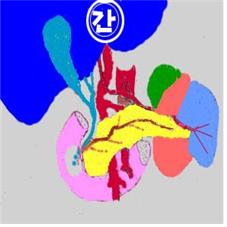
그림 69. 염증이 간에 생기면 간염이라고 한다
각종 질병을 치료할 때 쓰는 약물로 간염이 생길 수 있다.Copyright ⓒ 2011 John Sangwon Lee, MD., FAAP
5. 약물에 의한 신장염 Drug nephritis
-
배시트라신(Bacitracin), 카나마이신(Kanamycin), 벤코마이신(Vancomycin) 등 항생제, 페니실라민(Penicillamine), 약용 금, 수은제, 암포테리신, 납, 설파, INH, 비타민 D 등 약물로 치료 받을 때 그 약물 부작용으로 신장이 손상되어 신증후군, 신요석증, 신장염, 또는 신부전증 등이 생길 수 있다. [부모도 반의사가 되어야한다–소아가정간호백과]-제10권 소아청소년 신장 비뇨 생식기계 질환–신증후군 참조
-
신장염이 약물 알레르기로 생겼는지, 또는 약물 유해 작용이나 약물 부작용으로 생겼는지 확실히 알 수 없는 때도 있다.
-
약물에 의한 신장염 등이 생기면 쓰던 약물을 중지한다.
6. 약물 알레르기와 약물 부작용의 감별 진단 Differential diagnosis in drug allergy and drug side effects
-
약물로 치료 받을 때 약물 알레르기로 인해 아나필락시스, 혈청병, 또는 그 외 여러 가지 약물 알레르기, 약물 부작용, 약물 중독 등이 생길 수 있다.
-
약물 치료를 받을 때 항원 항체 이상반응으로 약물 알레르기도 생길 수 있고, 약물 알레르기가 아닌 약물 부작용, 또는 약물 유해 작용이 생길 수 있다.
-
약물 중독은 약물을 과량 사용해서도 생길 수 있고 그 외 다른 조건에 의해서도 생길 수 있다. 약물부작용 참조
-
어떤 병을 치료하기 위해 그 병에 적절한 약물을 선택해서 적절한 치료 용량으로 치료하는데도 약물로 인해 부작용이 생길 수 있고, 그 약물로 인해서 약물 유해 작용이 생길 수 있다.

그림 70. 비뇨기계 해부도.
a-좌우 신장, b-요관, c-방광, d-내 요도구 괄약근, e-외 요도구.
약물 부작용으로 염증이 신장에 생기면 신장염이리고 한다. 각종 질병을 치료할 때 쓰는 약물로 신장염이 생길 수 있다. Copyright ⓒ 2011 John Sangwon Lee, MD.FAAP
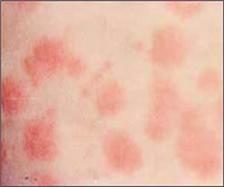
사진 71. 약물 알레르기로 생긴 피부 발진.
Copyright ⓒ 2011 John Sangwon Lee, MD., FAAP

사진 72. 약물 알레르기로 생긴 피부 발진.
Copyright ⓒ 2011 John Sangwon Lee, MD., FAAP
-
비정상적으로 쇠약한 신장, 간, 또는 다른 어떤 기관을 가진 아이들,
-
어떤 질병으로 인하여 몸이 쇠약한 아이들,
-
아주 유약한 신생아들,
-
노쇠한 노인들에게 생긴 어떤 질환을 아주 적절한 약물로 적절한 용량으로 치료할 때 그들에게 사용된 약물 대사가 건장한 사람들의 약물 신진대사와 같이 순조롭게 정상적으로 신진대사가 되지 않을 수 있다.
-
건강하지 않은 아이들의 질병을 적절한 약물을 선택해 적절한 용량으로 치료할 때도 혈 중 약 농도가 예기치 않게 비정상적으로 더 높아 그로 인해 약물 중독이나 약물 부작용이 생길 수 있다.
-
적절한 치료 용량으로 적절히 치료해도 어떤 약물은 신체의 어떤 계통의 특정 기관에 비정상적으로 과량 축적되어 그 기관의 기능이 저하되거나 상실될 수 있고 약물 부작용이나 약물 중독이 생길 수 있다.
-
어떤 감염병을 광범위 항생제로 장기간 치료할 때 호흡기계·소화기계·피부계 등의 상존 박테리아 무리나 곰팡이 무리가 비정상적으로 감소되거나 다 죽어 없어질 수 있다. 그 대신 평상시 상존하지 안했던 박테리아 및, 또는 곰팡이가 그 부위에 비정상적으로 더 많이 자라서 세균 무리 및, 또는 곰팡이 무리의 균형이 깨질 수 있다.
-
이 때 극히 해로운 세균이나 곰팡이 등이 비정상적으로 많이 증식돼 보통 때는 문제가 되지 안했던 비 상존 병원체 감염으로 생명에 위험한 중복감염이 생길 수 있다. 항생제 참조
-
결핵 치료약 아이나, 그 외 다른 약물로 약물 부작용이 간에 생겨 간염이 생길 수 있다.
-
클로람페니콜이나 그 외 약물로 부작용이 생겨 재생 불량빈혈이 생길 수 있다. [부모도 반의사가 되어야한다–소아가정간호백과]-제13권 소아청소년 혈액, 림프, 종양 질환–재생 불량빈혈 참조
-
카나마이신·스트렙토마이신·젠타마이신 등의 항생제 부작용으로 청신경 손상이 생길 수 있고, 귀가 먹을 수 있고 신장도 손상될 수 있다.
-
신장이 심하게 손상될 때 신장 부전증이 생겨 소변이 정상적으로 분비되지 않을 수 있다. [부모도 반의사가 되어야한다–소아가정간호백과]-제18권 소아청소년 이비인후 질환–약물과 난청 참조
-
백혈병이나 암 등을 치료하는 데 쓰는 항암제, 코르티코스테로이드제 등의 약물로 부작용이 생겨 면역 기능체계의 일부나 전체가 약화될 수 있고, 또 면역 기능 체계의 전부가 상실될 수 있다. 항암제 치료로 생긴 면역 기능 체계 이상으로 박테리아 감염이나 바이러스 감염, 또는 곰팡이 감염으로 감염병이 생길 수 있다. [부모도 반의사가 되어야한다–소아가정간호백과]-제13권 소아청소년 혈액, 림프, 종양 질환–약물로 인한 백혈구 감소증 참조
-
아스피린이나 그 밖의 약물로 부작용이 생겨 위장 점막이 손상될 수 있고 위염이나 위궤양이 생길 수 있다. 아스피린 치료로 혈액 응고 지연과 출혈이 생길 수 있다. 아스피린 참조
|
다음은“중이염과 삼출성 중이염 때문에 아이가 많이 힘들어 해요 ”에 관한 인터넷 소아청소년 건강상담 질의응답의 예 입니다. |
Q&A. 중이염, 삼출성 중이염 때문에 아이가 많이 힘들어 해요
Q.
- 저의 아이는 15개월이 되었어요. 밥도 잘 먹고 비교적 건강한 여자아이입니다.
- 지난달 4월30일경 밤에 보채 병원 응급실을 갔더니 중이염(오른쪽)이라 하여 외래 이비인후과에서 진료보고 약을 하루먹자 설사를 하여 집 가까운 이비인후과에 갔습니다.
- 거기서 세파쿨러라는 항생제 치료를 그때부터 2주정도 했는데 의사말 조금씩 밖에 나아지질 않는다며 옴니세프로 항생제를 교체하고 하루 먹이니 아이가 빨간 설사를 하였어요. 그러자 3일간 중지하였고 록시그란 이란 항생제로 바꾸어 주었어요. 항생제를 잠시 중지했던 3일간 사이에 감기가 걸려 후두염까지 되어 아이가 무척 힘들어하여 분당00병원 응급실로가 치료를 하고 다음 날부터 소아청소년과 를 다니면서 오구멘틴을 또 2주 정도 썼어요.
- 이후 또 세프템 건조시럽을 또 일주일 썼어요.
- 그래도 중이염이 나아지질 않았다고 소아청소년과에서는 바난건조 시럽을 일주일 처방을 내주었어요.
- 저는 이제 약을 먹이기가 정말로 아이도 약을 먹이고 나면 얼굴이 하얗게 되면서 힘들어해요
- 같은 병원 이비인후과 진료를 보았어요(소아청소년과 에서 청력 검사를 해 보라 하여). 이비인후과 의사는 항생제를 먹을 만큼 너무 많이 먹었으니 중지 해보자 합니다. 그러나 귀의 중이염은 아직 있다고 합니다.
- 저는 약을 계속 먹이자니 내성 같은 문제도 걱정이고 안 먹이자니 중이염이 심해질까 걱정이고 정말 어느 과 선생님 말을 들어야 할지 고민입니다.
- 아이는 지금은 잘 먹고 감기증상도 없어요.
- 약을 안 먹이고 있으면 어떻게 되나요? 또 점 점 강한 항생제를 많이 먹이면 이로 인해 우리아이가 또 다른 문제가 생기질 않을까요?
- 어떻게 해야 우리아이에게 가장 좋은 방법인지 정말 갈등입니다. 선생님 아이라 생각하시고 좋은 방안을 가르쳐 주세요.
A.
- 현숙님
- 안녕하십니까. 좋은 질문해 주셔서 감사합니다.
- 자녀의 나이와 성별, 과거 현재 가족의 병력, 증상 징후와 진찰소견, 적절한 임상검사 등의 결과를 종합해서 진단 치료하는 것이 이상적이지만 주신 정보를 참작해서 답변을 드립니다.
- 환자를 치료할 때는 항시 내 몸과 내 자식의 병을 치료하는 것 같이 하지요.
- 자식이 빵을 달라고 할 때 돌을 주지 않고 생선을 달라고 할 때 독사를 주지 않습니다.
- 우리 의사들은 그렇게 환자를 보지요.
- 상당히 혼동되시겠습니다.
- 아시겠지만 우리 소아청소년과 의사들은 거의 매일 빼놓지 않고 진료하는 병이 소아 중이염입니다.
- 소아 중이염의 원인 증상 진단 치료는 [부모도 반의사가 되어야 한다–소아가정간호백과]-제18권 소아청소년 이비인후 질환–중이염, 재발성 중이염, 만성 중이염, 삼출성 중이염 등을 참조하시기를 바랍니다.
- 박테리아성 급성 중이염은 여러 종류의 항생제 등 중 한 종류를 1차적으로 선택해서 치료합니다.
- 예를 들면, 경구용 아목사실린(Amoxillin)으로 약 10일 동안 1차적 치료를 해 본 다음 치료 시작 14일 경 추적(Follow up) 진찰을 해보고 중이염이 완치가 되지 않으면 오그멘틴(Amoxicillin/clavulante/Augmentin) 등으로 다시 약 10일간 치료하는 것이 일반적인 요즘 치료 방법입니다.
- 그러나 사는 나라에 따라 사는 지역에 따라, 그 동안 중이염을 치료했을 때 치료효과 등의 경험 등에 따라 1차적 또는 2차적 중이염 치료 선택 항생제의 종류는 다를 수 있습니다.
- 페니실린에 알레르기가 있는 아이들의 중이염을 세파크롤(Cefaclor), Cefuroxime(Ceftin/ Zinacef), 또는 그 외 항생제들 중 한 종류를 우선 선택해서 치료합니다.
- 이런 식으로 소아 박테리아 급성 중이염을 치료하면 잘 치료되는 것이 보통입니다.
- 드물게는 급성 중이염을 치료한 후 무균성 삼출성 중이염(Sterile otitis media/Serous otitis media)이 생길 수 있습니다. 이 때는 치료 방법이 다소 복잡해집니다.
- 무균성 삼출성 중이염의 정도에 따라 2~8주 동안 아무 약으로도 치료하지 않고 관찰적 치료만 할 수 있고 그 동안 한두 번 정도 그 경과를 알아보기 위해 추적 진찰해 보기도 합니다.
- 대부분 무균성 삼출성 중이염은 자연히 낫습니다.
- 때로는 무균성 삼출성 중이염이 낫지 않고 청력이 감소되기도 합니다.
- 이 때는 이비인후과에 의뢰해 이비인후과 의사가 고막 통기관을 꼽는 수술 치료도 합니다. 그 수술을 하는 시기는 때에 따라 다릅니다.
- 아마도 지금 여아 자녀의 중이염은 무균성 삼출성 중이염 상태에 있지 않은가 생각됩니다.
- 따라서 항생제로 치료하지 말고 관찰 치료만 하시고 2~3주 후에 그 무균성 삼출액이 중이에서 다 없어졌는지 확인하는 정도의 치료를 하면 된다고 생각됩니다.
- 관찰은 상당히 좋은 치료 방법 중 하나입니다.
- 연구에 의하면 급성 중이염을 항생제로 적절히 치료한 후 30일 경 추적 진찰에, 그 중이염 환자의 30% 정도는 중이 내 무균성 삼출액이 그냥 남아 있을 수 있고, 또 90일 경에도 약 10% 정도 그 중이 내 무균성 삼출액이 남아 있을 수 있다고 합니다.
- 급성 중이염을 적절히 치료 한 후에도 중이 강 내 무균성 삼출액이 오랫동안 남아 있을 수 있다는 연구입니다.
- 이런 경우 대부분은 알레르기 비염이나 천식 등의 알레르기 질환을 함께 앓고 있습니다.
- 무균성 삼출 중이염을 가진 아이들의 아데노이드가 커져 있을 수 있고 알레르기 비염도 동시 있을 수 있습니다. 그래서 알레르기 비염을 동시 치료하는 경우도 많습니다. 오늘은 이 정도로 말씀드리겠습니다.
- 제가 드린 말씀은 주신 정보를 토대로 해서 말씀드린 것을 이해해 주시고 단골 소아청소년과 의사의 계속적인 치료를 받으시기 바랍니다. 감사합니다. 이상원 드림
Serum sickness caused by drugs 약물로 인한 혈청병

Picture 59. A leg split by a purple plaque on the Henochshin line caused by a serum disease. Copyright ⓒ 2011 John Sangwon Lee, MD., FAAP

Picture 60. Serum disease can occur after being stung by a bee. Copyright ⓒ 2011 John Sangwon Lee, MD., FAAP
Causes of serum sickness caused by drugs
• Serum disease is an immune complex reaction caused by an antigenic antibody reaction and is a type of delayed drug allergy.
• I had this disease in the past when I was treated with a serum medicine made from cow or horse serum to treat tetanus, diphtheria, and other infectious diseases.
• Serum of cattle or horses may contain specific antibodies that can kill certain bacteria, or other types of proteins, or antigens, are present in the serum.
• Treatment with serum containing specific antibodies is a type of passive immunotherapy.
• There are antibodies in the serum used for passive immunotherapy, but there are also other types of proteins or antigens.
• The antigen in the serum drug component and the antibody in the body cause an adverse reaction, which can lead to a serum disease.
• Serum diseases can occur when treating certain diseases with such as serum medicine made from cow or horse serum, medicine made from human blood, or antibiotics. See drug intolerance
• Serum disease may appear 1 to 3 days after treatment with drugs containing serum components (serum drugs), and may appear around 1 to 4 weeks.
• Being treated with anti-toxin (anti-serum toxin) serum medications, or medications such as penicillin, sulfonamide, dextran, cephalosporin, or any other type of medication, eating, drinking, inhaling, nasal or oral , Applying to the skin or mucous membranes, placing them in the anus or vaginal cavity, stinging or biting insects such as bee stings, or eating any food can cause serum disease.
• Anaphylaxis, serum sickness, or side effects from drugs may occur when drugs containing animal serum components are given by injection or when treated with antibiotics such as penicillin, sulfa drugs, and streptomycin. See p.00 Penicillin Allergy
Symptoms, Signs of Serum Disease Due to Drugs
• Typical symptoms of serum sickness include fever, hives, skin itching, hives and other skin rashes, joint pain, arthritis, muscle pain, lymph node enlargement, and fatigue.
• Hives caused by serum sickness are usually more severe and are therefore quite itchy.
• If the symptoms of most serum diseases appear and are treated appropriately immediately after the symptoms appear, it is common for the symptoms of serum diseases to continue for about a week and then heal naturally.
• Rarely, a serum disease can lead to heart disease and glomerulonephritis. www.drleepediatrics.com-Refer to Volume 10 Child and Adolescent Kidney Urogenital Diseases-Nephrotic syndrome
Diagnosis of serum diseases caused by drugs
• It can be diagnosed by combining medical history, symptoms, and examination findings
• Serum disease can be diagnosed by taking into account the fact that you have been injected with a serum drug, have been treated with other drugs, or have been stung by an insect such as a bee. • Since the initial symptom signs of serum disease are often similar to those of other diseases, it is necessary to differentiate between serum disease and other diseases.
Treatment of serum diseases caused by drugs
• Mild serum sickness can be treated with appropriate medications at home as directed by a doctor.
• Serum disease is treated with first-generation antihistamines such as Benadryl or Atrax, or with corticosteroids and/or antihistamines.
• Drugs that are thought to have caused serum sickness should no longer be used. • Severe serum sickness requires hospital inpatient treatment.
Prevention of serum diseases caused by drugs
• You should no longer be exposed to drugs or other antigens that have caused serum sickness in the past. Serum disease is prevented almost the same as when preventing anaphylaxis.
Differential drug diagnosis of drug allergy versus drug side effects
1.Drug eruption (drug eruption)
• Drug-induced skin rash is called drug skin rash, drug rash, or prickly rash. • You may develop a drug allergy when receiving medication. • Hives, blisters, molting, erythema, papules, erythematous papules, and skin rashes that are almost similar to measles flowers may occur. www.drleepediatrics.com-Vol. 17 Child and Adolescent Skin Diseases-Refer to Skin Rash
• Skin rash may occur as a side effect of the drug.
• A skin rash can also occur due to adverse drug effects.
• Sometimes it is difficult to tell if a skin rash is caused by an adverse drug reaction, a drug allergy, or an adverse drug reaction. • The skin rash that occurs at this time is simply called “drug rashes”.

Picture 61. Drug-induced skin rash (breakout). Copyright ⓒ 2011 John Sangwon Lee, MD.,FAAP

Picture 62. Drug-induced skin rash (breakthrough). Copyright ⓒ 2011 John Sangwon Lee, MD., FAAP

Picture 65. Drug-induced skin rash (breakthrough). Copyright ⓒ 2011 John Sangwon Lee, MD., FAAP

Picture 66. Drug-induced skin rash Copyright © 2011 John Sangwon Lee, MD., FAAP.

Picture 63. Drug-induced skin rash (advanced) Copyright ⓒ 2011 John Sangwon Lee, MD., FAAP

Photo 64. Drug-induced skin rash (advanced) Copyright ⓒ 2011 John Sangwon Lee, MD.,FAAP
2. Drug fever (drug fever)

Figure 67. When treated with drugs, fever can occur due to drug side effects or drug allergies. Copyright ⓒ 2011 John Sangwon Lee, MD., FAAP
• Fever may occur due to drug allergy resulting from adverse drug antigen antibody reactions, • When receiving medication, you may have a fever as a symptom of a side effect of the medication.
• Fever can be caused by adverse drug reactions.
• You may have a fever as a symptom of a drug allergy and a fever as a side effect of drugs.
• When a disease is treated with a drug, when you are not sure whether the fever is caused by the drug allergy, the fever is caused by a drug allergy, or the fever is caused by adverse drug reactions. It is called fever, or drug fever. • At this time, you may get a fever of 38 to 43 degrees Celsius.
• During treatment with antibiotics such as penicillin or cephalosporin, anticonvulsants such as phenytoin or phenobarbital, anti-tumor drugs such as Daunorubicin, etc. This can fly.
• Drug fever usually begins 7 to 10 days after the start of medication.
• The fever usually falls within 2 to 3 days after stopping the medication, sometimes accompanied by eosinophils and skin rash.
3. Drug pneumonitis

Picture 68. Pneumonia is in the left lung. Pneumonia can occur as a side effect of the drug. Copyright ⓒ 2011 John Sangwon Lee, MD., FAAP
• Pneumonia can occur as a side effect of drugs when using heroin, methadone, or other addictive drugs, or when treated with other drugs, or as a result of a drug allergy.
• In addition, pneumonia may occur due to adverse drug effects.
• Pulmonary edema can also occur due to abnormal fluid buildup in the lungs due to drugs.
• In some cases, it is not clear whether pneumonia is caused by a drug allergy, pneumonia as a result of a drug reaction, or pneumonia as a result of adverse drug reactions. • Stop taking the old medication and treat it appropriately with other medications.
4. Drug hepatitis
• Hepatitis can be caused by INH/Isoniazid used to treat tuberculosis, Sulfa drugs or Erythromycin, which are used to treat bacterial (bacterial) infectious diseases, and other types of drugs.
• At this time, it is sometimes unclear whether the hepatitis is caused by a drug allergy, a drug reaction, or a drug side effect.
• If you suspect you have a drug-borne infection, stop using your old drug.

Figure 69. Inflamed liver is called hepatitis Hepatitis can be caused by drugs used to treat various diseases. Copyright © 2011 John Sangwon Lee, MD., FAAP
5. Drug nephritis
• Receive treatment with antibiotics such as Bacitracin, Kanamycin, and Vancomycin, penicillamine, medicinal gold, mercury, amphotericin, lead, sulfa, INH, and vitamin D. When the side effects of the drug damage the kidneys, nephrotic syndrome, nephrolithiasis, nephritis, or kidney failure may occur. www.drleepediatrics.com]-Refer to Volume 10 Child and Adolescent Kidney Urogenital Diseases-Nephrotic syndrome
• Sometimes it is not clear whether nephritis is caused by a drug allergy, or as a result of adverse drug or side effects.
• If you develop nephritis caused by medication, stop using the medication.
6. Differential diagnosis in drug allergy and drug side effects
• When treated with drugs, anaphylaxis, serum sickness, or other drug allergies, drug side effects, drug addiction, etc. may occur due to drug allergies.
• When receiving drug treatment, drug allergies may occur due to adverse reactions to antigens and antibodies, and adverse drug reactions or adverse drug reactions may occur.
• Substance addiction can result from overdose of drugs and other conditions. See drug side effects
• In order to treat a disease, the drug may cause side effects, and adverse effects may occur due to the drug, even when the drug is selected and treated with an appropriate therapeutic dose.

Figure 70. Anatomy of the urinary system. a-left and right kidney, b-ureter, c-bladder, d-inner ureteral sphincter, e-external ureter. If inflammation occurs in the kidney as a side effect of the drug, it is called nephritis. Nephritis can occur with medications used to treat various diseases. Copyright ⓒ 2011 John Sangwon Lee, MD.FAAP

Picture 71. A skin rash caused by a drug allergy. Copyright ⓒ 2011 John Sangwon Lee, MD., FAAP

Picture 72. A skin rash caused by a drug allergy. Copyright ⓒ 2011 John Sangwon Lee, MD., FAAP
• Children with abnormally weak kidneys, liver, or any other organ, • Children who are weak due to certain diseases,
• very fragile newborns,
• Certain diseases in senile older people may not be metabolized as smoothly as those in healthy people when the drug metabolism used for them is treated at the right dose with very appropriate drugs.
• Even when the disease of unhealthy children is treated with an appropriate drug and at an appropriate dose, the drug concentration in the blood is unexpectedly and abnormally high, which can lead to drug addiction or drug side effects.
• Even with appropriate treatment at the appropriate therapeutic dose, certain drugs may accumulate abnormally in excess in certain organs of certain systems in the body, resulting in decreased or lost function of those organs, and drug side effects or drug addiction may occur.
• When a certain infectious disease is treated with broad-spectrum antibiotics for a long period of time, a group of bacteria or fungi such as the respiratory, digestive and skin systems may be abnormally reduced or disappeared altogether. Instead, bacteria and/or fungi that were not normally present may grow abnormally in the area, causing the bacterial and/or fungal clusters to become unbalanced.
• At this time, extremely harmful bacteria or fungi are abnormally multiplied, which can lead to life-threatening multiple infections due to non-existing pathogen infections that were not normally a problem. See antibiotics
• Drugs for tuberculosis or other drugs can cause side effects in the liver, resulting in hepatitis. • Chloramphenicol or other drugs can cause side effects, leading to aplastic anemia.
www.drleepediatrics.com-Vol. 13 Pediatric and Adolescent Blood, Lymph, and Tumor Diseases-See Aplastic Anemia
• Side effects of antibiotics such as kanamycin, streptomycin, gentamicin, etc. can cause damage to the auditory nerve, eat ears, and damage the kidneys.
• When the kidneys are severely damaged, kidney failure may occur and urine may not be secreted normally. [Parents should also be anti-doctors-Pediatric and Family Nursing Encyclopedia]-Refer to Volume 18, Children’s and Adolescent Otolaryngeal Diseases-Drugs and Hearing Loss
• Drugs such as anticancer drugs and corticosteroids used to treat leukemia or cancer may cause side effects, which may weaken some or all of the immune system, and may cause the entire immune system to be lost. Infectious diseases can be caused by bacterial infections, viral infections, or fungal infections due to abnormal immune function caused by chemotherapy. [www.drleepediatrics.com-Vol. 13 Pediatric and Adolescent Blood, Lymph, and Tumor Diseases-Refer to Drug-induced Leukopenia
• Side effects of aspirin or other drugs can damage the gastrointestinal mucosa and cause gastritis or gastric ulcers. Aspirin treatment can delay blood clotting and cause bleeding. See aspirin
The following is an example of a question-and-answer on the Internet pediatric and adolescent health counseling on “My child is having a lot of trouble because of otitis media and otitis media exudative.”
Q&A.
Otitis media, exudative otitis media, the child is having a lot of trouble
Q.
• My child is 15 months old. She is a relatively healthy girl who eats well.
• I went to the emergency room of Bochae Hospital on the night of April 30 last month, and it was called otitis media (right), so I went to an outpatient otolaryngology department to see the medicine and had diarrhea.
• There, I had been treated with an antibiotic called Sepha Cooler for about 2 weeks from that time, but the doctor said that it only improved little by little. After replacing the antibiotic with Omnice, and feeding it a day, my child had red diarrhea. Then she stopped for 3 days and switched to an antibiotic called Roxy Gran. During the 3 days when I stopped antibiotics, my child got a cold and got laryngitis, so the child was very difficult. I went to the emergency room at Bundang 00 Hospital for treatment. • After that, she used Septem Dry Syrup for another week.
• Still, the otitis media did not improve, so the Department of Pediatrics and Adolescents gave a weekly prescription of Banan dry syrup.
• Now I’m really struggling with medication as the child turns her face white after medication
• I went to the otolaryngology department at the same hospital (to have a hearing test at the Pediatrics and Adolescents department). Your otolaryngologist has taken too much antibiotics, so let’s stop. However, it is said that ear infections are still present.
• I am worried about problems such as tolerance as I continue to take medicine, and I am worried that my otitis media will get worse if I do not take it, and I am really worried about which class to listen to.
• The child eats well now and does not have any cold symptoms
. • What if I’m not taking medication? Also, if I take a lot of strong antibiotics, will this cause my child to have another problem?
• It’s really a conflict about what to do in the best way for my child. Think of it as a teacher, and tell me a good idea A.
• Hyunsook • Hello. Thanks for the great question.
• It is ideal to conduct diagnostic treatment by combining the results of the child’s age and gender, past and present family medical history, symptoms, signs and examination findings, and appropriate clinical tests, but we will respond based on the information provided.
• When treating a patient, I always do it like treating my body and my child’s illness.
• When a child asks for bread, he does not give stones, and when he asks for fish, he does not give vipers.
• Our doctors look at patients that way.
• You will be quite confused.
• As you may know, the disease that our pediatricians treat almost every day is otitis media.
• Refer to www.drleepediatrics.com-Vol. 18 Children’s and adolescent ENT diseases-Otitis media, recurrent otitis media, chronic otitis media, otitis media exudative .
• Bacterial acute otitis media is treated primarily with one of several antibiotics.
• For example, first-line treatment with oral amoxillin for about 10 days, then follow up 14 days after the start of treatment, and if otitis media is not cured, amoxicillin/clavulante /Augmentin), etc., for about 10 days again, is a common treatment nowadays. • However, depending on the country you live in, the region you live in, and the experience of treating otitis media in the past, treatment options for otitis media may be different.
• Otitis media in children allergic to penicillin is treated first with either Cefaclor, Cefuroxime (Ceftin/Zinacef), or other antibiotics.
• Treating pediatric bacterial acute otitis media in this way usually works well.
• Rarely, after treatment of acute otitis media, Sterile otitis media (Serous otitis media) may develop. In this case, the treatment method becomes somewhat complicated.
• Depending on the severity of aseptic exudative otitis media, observational treatment can be performed without any medications for 2 to 8 weeks, during which time a follow-up examination may be conducted to determine its progress.
• Most aseptic exudative otitis media heals naturally.
• Sometimes, aseptic exudative otitis media does not heal and hearing is reduced.
• In this case, an otolaryngologist is referred to the otolaryngologist for surgical treatment in which the eardrum vents are inserted. The timing of the operation varies from time to time.
• Perhaps your girl’s otitis media is aseptic exudative otitis media.
• Therefore, I think that it is only necessary to do observational treatment instead of antibiotics, and to check whether the aseptic exudate has disappeared from the middle ear after 2 to 3 weeks.
• Observation is one of the best treatment options.
• According to research, at follow-up 30 days after appropriate treatment of acute otitis media with antibiotics, about 30% of patients with otitis media may still have aseptic effusion in the middle ear, and about 10% after 90 days It is said that sterile exudate may remain in the middle ear.
• Studies show that even after adequate treatment of acute otitis media, sterile effusion in the middle ear can remain for a long time.
• Most of these cases have allergic diseases such as allergic rhinitis or asthma.
• Children with aseptic effusion otitis media may have enlarged adenoids and may also have allergic rhinitis. Therefore, it is often treated simultaneously with allergic rhinitis. Today I will tell you about this.
• Please understand what I said based on the information I have given you, and continue to receive treatment from your regular pediatrician. Thank you. Lee Sang-won.MD
출처 및 참조 문헌 Sources and references
- NelsonTextbook of Pediatrics 22ND Ed
- The Harriet Lane Handbook 22ND Ed
- Growth and development of the children
- Red Book 32nd Ed 2021-2024
- Neonatal Resuscitation, American Academy Pediatrics
- www.drleepediatrics.com제8권 소아청소년 호흡기 질환
- www.drleepediatrics.com제9권 소아청소년 소화기 질환
- www.drleepediatrics.com제10권. 소아청소년 신장 비뇨 생식기 질환
- www.drleepediatrics.com제11권. 소아청소년 심장 혈관계 질환
- www.drleepediatrics.com제12권. 소아청소년 신경 정신 질환, 행동 수면 문제
- www.drleepediatrics.com제13권. 소아청소년 혈액, 림프, 종양 질환
- www.drleepediatrics.com제14권. 소아청소년 내분비, 유전, 염색체, 대사, 희귀병
- www.drleepediatrics.com제15권. 소아청소년 알레르기, 자가 면역질환
- Red book 29th-31st edition 2021
- Nelson Text Book of Pediatrics 19th — 21st Edition
- The Johns Hopkins Hospital, The Harriet Lane Handbook, 22nd edition
-
Childhood Emergencies in the Office, Hospital and Community, American Academy of Pediatrics
-
Emergency Medical Service for Children, By Ross Lab. May 1989. p.10
-
Emergency care, harvey grant and robert murray
-
Emergency Care Transportation of Sick and Injured American Academy of Orthopaedic Surgeons
-
Emergency Pediatrics A Guide to Ambulatory Care, Roger M. Barkin, Peter Rosen
-
Immediate care of the acutely ill and injured, Hugh E. Stephenson, Jr
-
The Critically Ill Child, Diagnosis and Management, Edited by Clement A. Smith
-
Emergency Medical Services for Children: The Role of the Primary Care Provider, America Academy of Pediatrics
-
Quick Reference To Pediatric Emergencies , Delmer J. Pascoe, M.D., Moses Grossman, M.D. with 26 contributors
-
Manual of Emergency Care
-
응급환자관리 정담미디어
-
소아가정간호백과–부모도 반의사가 되어야 한다, 이상원
-
Neonatal Resuscitation American heart Association
-
Neonatology Jeffrey J.Pomerance, C. Joan Richardson
-
Pediatric Resuscitation Pediatric Clinics of North America, Stephen M. Schexnayder, M.D.
-
Pediatric Critical Care, Pediatric Clinics of North America, James P. Orlowski, M.D.
-
Preparation for Birth. Beverly Savage and Dianna Smith
- Infectious disease of children, Saul Krugman, Samuel L Katz, Ann A. Gershon, Catherine Wilfert
-
The Harriet Lane Handbook 19th Edition
-
소아과학 대한교과서
-
제1권 소아청소년 응급의료 참조문헌과 출처
-
Other
Copyright ⓒ 2015 John Sangwon Lee, MD., FAAP
“부모도 반의사가 되어야 한다”-내용은 여러분들의 의사로부터 얻은 정보와 진료를 대신할 수 없습니다.
“The information contained in this publication should not be used as a substitute for the medical care and advice of your doctor. There may be variations in treatment that your doctor may recommend based on individual facts and circumstances. “Parental education is the best medicine.”